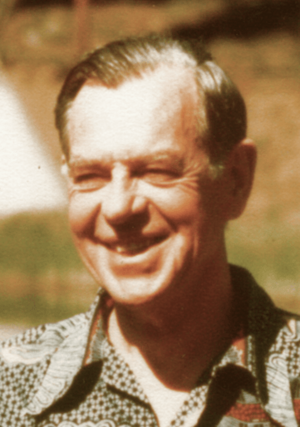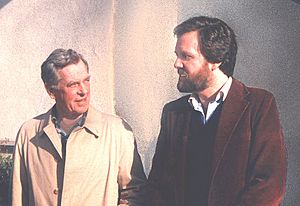Joseph Campbell facts for kids
Quick facts for kids
Joseph Campbell
|
|
|---|---|

Campbell in the late 1970s
|
|
| Born |
Joseph John Campbell
March 26, 1904 White Plains, New York, U.S.
|
| Died | October 30, 1987 (aged 83) Honolulu, Hawaii, U.S.
|
| Education | Dartmouth College Columbia University (BA, MA) |
|
Notable work
|
The Hero with a Thousand Faces (1949) |
| Spouse(s) | |
| Scientific career | |
| Institutions | Sarah Lawrence College |
| Academic advisors | Roger Sherman Loomis |
| Influences | |
| Influenced |
|
Joseph John Campbell (born March 26, 1904 – died October 30, 1987) was an American writer and teacher. He was a professor of literature at Sarah Lawrence College. Campbell studied and wrote about comparative mythology and comparative religion. This means he looked at stories, myths, and beliefs from different cultures around the world to find common ideas.
Campbell's most famous book is The Hero with a Thousand Faces, published in 1949. In this book, he wrote about the idea of the "Monomyth" or "hero's journey." This is a pattern of stages that many heroes in myths and stories seem to follow.
Many modern writers and artists have used Campbell's ideas. For example, George Lucas, the creator of Star Wars, said that Campbell's work greatly influenced his movies. Campbell's philosophy can be summed up by his famous phrase: "Follow your bliss."
Contents
Who Was Joseph Campbell?
Early Life and Education
Joseph Campbell was born in White Plains, New York, on March 26, 1904. He grew up in an Irish Catholic family. As a child, his family moved to New Rochelle, New York.
In 1921, Campbell finished school at the Canterbury School. He then went to Dartmouth College where he first studied science. However, he soon realized he was more interested in the humanities, which include subjects like literature and philosophy. He then moved to Columbia University. There, he earned a Bachelor of Arts degree in English literature in 1925. He also got a Master of Arts degree in medieval literature in 1927.
Campbell was also a talented athlete. He won awards in track and field. For a while, he was one of the fastest half-mile runners in the world.
Travels and New Interests
In 1924, Campbell traveled to Europe with his family. On his way back, he met Jiddu Krishnamurti, a spiritual leader. They talked about Indian philosophy, which made Campbell very interested in the ideas and stories from India.
In 1927, Campbell received a special scholarship from Columbia University to study in Europe. He studied Old French, a language from the past, and Sanskrit, an ancient Indian language. He studied at the University of Paris and the University of Munich. He learned to read and speak both French and German.
When he returned to Columbia University in 1929, Campbell wanted to study Sanskrit and modern art. However, his professors did not approve these new studies. So, Campbell decided to leave his graduate studies. He later joked that it was a sign of being good at his job not to have a PhD in the subjects he studied.
A Time of Deep Study
During the Great Depression, a time when many people had no jobs, Campbell spent five years (1929–1934) living in a small rented house in Woodstock, New York. During this time, he studied on his own very intensely. He later said he would read for nine hours a day, every day, for five years. This period of deep reading helped him develop many of his ideas.
For one year in 1933, Campbell taught at the Canterbury School in Connecticut. During this time, he also tried to publish his own fiction stories. He sold his first short story, Strictly Platonic, to Liberty magazine.
Teaching and Later Life
Professor at Sarah Lawrence College
In 1934, Joseph Campbell became a Professor of Literature at Sarah Lawrence College in Yonkers, New York. In 1938, he married Jean Erdman, who was a dancer and choreographer. She had been one of his students. They were married for 49 years and lived in a small apartment in New York City. Later in life, they also bought an apartment in Honolulu, Hawaii, and split their time between the two cities. They did not have any children.
During World War II, Campbell met Heinrich Zimmer, an expert on India. They became good friends. After Zimmer passed away, Campbell took on the important job of editing and publishing Zimmer's writings. This work took him about ten years.
In 1955–1956, Campbell took a break from teaching and traveled to Asia for the first time. He spent six months in India and another six months in Japan. This trip greatly influenced his ideas about Asian religion and myths. It also showed him how important it was to teach comparative mythology to a wider audience, not just in universities.
Campbell retired from Sarah Lawrence College in 1972, after teaching there for 38 years.
Final Years and Legacy
In 1986, Campbell went to a concert by the band Grateful Dead. He was amazed by how everyone at the concert felt connected. He even put on a conference with the band called "Ritual and Rapture from Dionysus to the Grateful Dead."
Joseph Campbell passed away at his home in Honolulu, Hawaii, on October 30, 1987. He died from complications of esophageal cancer. Before he died, he had finished filming a series of interviews with Bill Moyers. These interviews were shown on TV the next spring as The Power of Myth. This series made his ideas even more famous. He is buried in O'ahu Cemetery, Honolulu.
See also
 In Spanish: Joseph Campbell para niños
In Spanish: Joseph Campbell para niños


